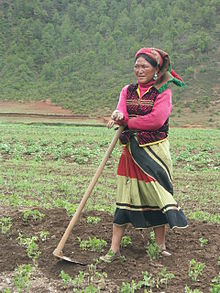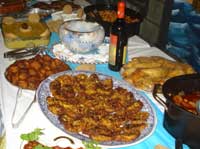MATRIARCHY: DARING TO USE THE “M” WORD
For me the word “matriarchy” expresses the certainty that “another world” can exist—a world not based in domination and hierarchy or violence and war.
The word “matriarchy” makes people’s hair stand on end as they imagine the mirror-image of patriarchy: societies in which women dominate men, beat men, rape men, hold men as slaves, and demand obedience from men. Some who do not protest very loudly or at all against patriarchy are horrified by the very idea of matriarchy. To be fair, most feminists have also been schooled not to use the “m” word.
Early in my academic career, I read “The Myth of Matriarchy” by Joan Bamberger and learned that the idea of matriarchy gone wrong has been used by men to justify patriarchy. From other academics I learned that in matrilineal societies, uncles have a great deal of power—so therefore there never was a matriarchy. I was also aware that Jungian and other proponents of a “matriarchal stage” in the development of culture have argued that matriarchy had to be succeeded by patriarchy in order for societies to evolve to a “higher” stage. Unlike many of my colleagues I stubbornly held onto the belief that there must have been “a better way” prior to patriarchy.
But I also learned that to use the “m” word was equivalent to committing academic suicide. So I choose my words carefully and spoke of “pre-patriarchal” societies where women were honored, people lived in harmony with each other and nature, and there was no war. Or like Marija Gimbutas, I spoke of societies that were “matrilineal and matrilocal” and worshipped the Goddess as the symbol of the cycles birth, death, and regeneration in all things.
I didn’t have a clear picture of how such societies might be organized until I read Societies of Peace by Heide Goettner-Abendroth. Through her work and that of a growing cohort of indigenous people who have come forth to speak about their own societies, matriarchy has been given a new and more precise definition.
Goettner-Abendroth rejects the common definition of matriarchy as “mother-rule” with the connotation of “female domination.” Instead she argues that matriarchies are societies that honor mothers and consider care and generosity–values they associate with motherhood–to be the highest values. In affirming values associated with motherhood, matriarchal societies are not essentialist. They do not affirm that only women can be nurturers of life. Quite the opposite, they assert that the highest role for anyone–male or female or other–is to nurture life. This is so far from the way we think, that it will be easy to misconstrue what is being said.
Matriarchal societies are generally in the early stages of agriculture (small scale or before the plow), they are egalitarian, they are matrilineal (tracing descent through the motherline), and they are usually matrilocal (with women and sometimes men staying in the mother clan).
In matriarchal societies, men are not dominated, and as anthropologists have long understood, men do hold power as brothers and uncles. However, men do not dominate, because mothers and grandmothers also hold power. Together great-uncles and grandmothers create an egalitarian system where everyone’s voice can be heard. The power to dominate is not held to be the highest value.
In matriarchal societies sex and love really are free because they are not tied up with providing for a family or caring for children. The matriarchal clan remains at the center of life; children are brought up by the maternal clan, including mothers, aunts and grandmothers, brothers and uncles. Lovers are free to come together and to part.
Land is held by the female clans and inequalities are erased by a wide-spread practice of gift-giving. Those who have more hold parties and feasts where what they have is shared rather than hoarded. In matriarchal societies the earth is generally understood to be a Great and Giving Mother and her generous gift of Life is celebrated in rituals that celebrate her as the Source of Life.
In some parts of the world matriarchies have been superseded by patriarchy, but not everywhere. Matriarchal societies still exist today in the Himalayas and in parts of Indonesia, as well as in areas in Africa and the Americas.
When I first read Societies of Peace a few years ago, I found it to be the “rosetta stone” that made sense of a series of individual insights I had about the ancient culture of Crete. Among those are the following.
Over years of visiting museums, I realized that a large number of the artifacts from ancient Crete were pouring vessels. As most of these were found in ritual contexts, it made sense to think of them as having been used to pour libations of liquid onto altars and the earth, returning the gifts that had been given to human beings to Mother Earth.
Over the years I have been struck many times by the generosity of the Cretan people, especially those who live in rural areas. Could it be, I wondered, that the idea that the earth is a Great and Giving Mother is connected to the “teaching” still alive today in Crete that nothing is more important than to give and to receive in the circle of life?
It seemed to me that the spirit of great generosity I experienced in Crete was not rooted in the idea of giving as self-denial that I had been taught in Sunday school. Although I experienced great generosity in my childhood—especially from my grandmother who fed us all on Sunday afternoons—I was also taught that “giving to others” is a duty and that it should be done “selflessly” with no expectation of return, and perhaps “joylessly” as well.
In Crete I learned a different lesson. I met people who love to give and who consider giving to others on a daily basis to be a part of life. The people I met also enjoyed receiving. For them life is a circle that includes self and other. Self-denial was not a part of it. To give is to live. But so is to receive. Recognizing the two together is, I believe, the essence of the matriarchal worldview.
Recently, I have begun to use the words “matriarchy” and “matriarchal” even though recognizing that they may be misunderstood. For me the word matriarchy expresses the certainty that “another world” can exist—a world not based in domination and hierarchy or violence and war. I have experienced matriarchal values in Crete and learned about them from the work of Heidi Goettner-Abendroth and her colleagues, but these values were also passed on to me by my grandmother.
I proudly use the “m” word in honor of her and of all of those who have taught me that “another way” is possible.
(However I intend to use the word precisely. Worshipping the Goddess or Goddesses does not make a society matriarchal.)
See “Matriarchy” by Peggy Reeves Sanday and my “Exciting New Research on Matriarchal Societies.”
Carol P. Christ created a newly released new website for the Goddess Pilgrimage to Crete which she leads through Ariadne Institute. Early bird special for the spring pilgrimage extended. Carol can be heard on a WATER Teleconference. Carol’s books include She Who Changes and Rebirth of the Goddess and the widely-used anthologies Womanspirit Rising and Weaving the Visions.
originally published on www.feminismandreligion.com

